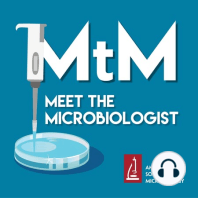24 min listen

095: The Evolution of Virulence with Andrew Read
095: The Evolution of Virulence with Andrew Read
ratings:
Length:
56 minutes
Released:
Nov 15, 2018
Format:
Podcast episode
Description
In the early 2000s, Andrew Read predicted that non-sterilizing vaccines would lead to more virulent disease. He was able to test his hypothesis with the real-world example of Marek’s disease, a disease of chickens. Read tells the story of his discovery, and talks about his work on myxoma virus. Take the MTM Listener Survey Subscribe (free) on Apple Podcasts, Google Podcasts, Android, RSS, or by email. Also available on the ASM Podcast Network app. Julie’s Biggest Takeaways: Every chicken on the market is vaccinated against Marek’s disease. Infection with Marek’s disease causes tumors on the bird and can lead to direct death, or condemnation of a flock requiring their culling. Birds are vaccinated with a live, attenuated virus, and there have been 3 vaccine iterations. The first used a related herpesvirus isolated from turkeys, while the second vaccine added a second virus strain. Each of these vaccines conferred protection for about 10 years, after which the disease began popping up again. The 3rd generation vaccine added yet another serotype - this additional strain is a mutant strain of the chicken-infecting serotype - and has been effectively protecting chickens since the 1990s. Chickens do not get sterilizing immunity from the Marek’s disease vaccine; they can be infected by the wild-type virus, but the vaccine prevents infected animals from having disease symptoms. These asymptomatically infected animals can still shed the virus. Contrast this to human immunity from many of our vaccines, such as measles or smallpox vaccines, in which our immune response stops the virus from entering our cells and therefore blocks virus replication. Vaccination inhibits strains with lower virulence more than strains with higher virulence. This fact, combined with asymptomatic infection, means that although the infected birds don’t show disease symptoms, they are more likely to be shedding more virulent (or ‘hot’) strains. This generates selection for these hot strains that wouldn’t normally be successful. Without vaccination, host strains kill the host too quickly to allow viral replication and transmission to occur; Vaccines allow these hot strains to propagate. Vaccine resistance is much more rare than antibiotic or antimicrobial resistance. This is due to a number of factors, including the diversity of microbial population being acted upon (small with initial infection, large when treated with antimicrobial drugs). Vaccines are much more evolution-proof for these reasons. Purposeful release of myxoma virus during the 1950s in Australia killed between 10 and 100 million animals, or 99.9% of the rabbit population. Frank Fenner followed the virus and surviving rabbit populations and discovered that myxoma viruses that were too virulent were less likely to be transmitted, because they killed the host too quickly. He also showed that the small surviving number of rabbits were more resistant to viral infection. The arms race between the two has generated a virus so immunosuppressive that Read’s group has found the currently circulating myxoma virus has changed the way it kills its host: the virus disables the rabbit immune system and allows the rabbit’s own microbiome to cause invasive bacterial disease.
Released:
Nov 15, 2018
Format:
Podcast episode
Titles in the series (100)
MTS6 Bruce Rittmann - Microbes, Waste and Renewable Energy by Meet the Microbiologist